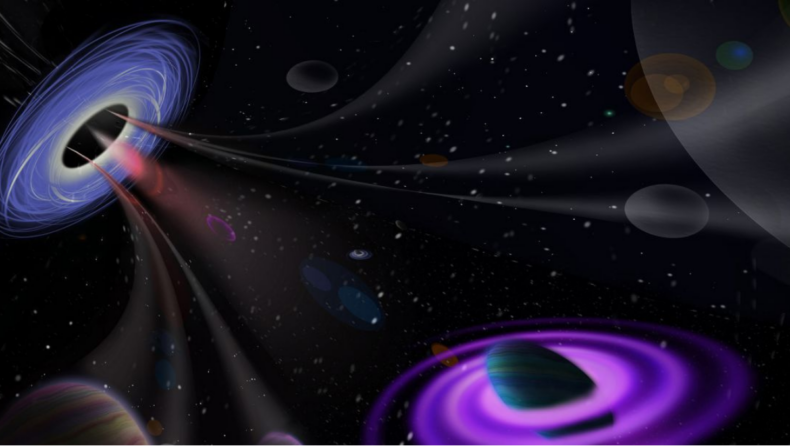A seemingly unsolvable black hole paradox postulated by physicist Stephen Hawking could finally be solved – thanks to wormholes traversing space-time.
Hawking discovered that black holes aren’t completely black in the 1970s, but he didn’t recognize the massive problem he had caused at the time. Black holes were thought to be extremely simple before his discovery, according to physicists. Sure, all kinds of sophisticated information fell into them, but the black holes sucked it all in and never let it out.
Hawking discovered, however, that black holes emit radiation and can eventually evaporate completely, a process known as Hawking radiation.
However, that radiation did not carry any information. It couldn’t, because a black hole’s event horizon, by definition, precludes information from exiting. So, when a black hole finally evaporates and vanishes from the universe, where does all the information it has hidden away go?
This is the information paradox of the black hole. One possibility is that information can be destroyed, which appears to go against all of our understanding of physics. (If information can be lost, for example, you won’t be able to reconstruct the past from current occurrences or forecast the future.)
Instead, most physicists strive to solve the puzzle by figuring out a way for the information inside the black hole to escape via Hawking radiation. As a result, even if the black hole vanishes, the information remains in the cosmos.
The “black hole information paradox” refers to the fact that while information cannot be destroyed in the cosmos, whatever information was sucked up by this cosmic vacuum cleaner should have long since perished when the black hole finally dissipates.
The conundrum could be overcome by nature’s ultimate cheat code: wormholes, or space-time passageways, according to the new research.
In a statement, Kanato Goto, a theoretical physicist at the RIKEN Interdisciplinary Theoretical and Mathematical Sciences Program in Japan, said, “A wormhole connects the inside of the black hole with the radiation outside, like a bridge.”
A second surface appears inside the event horizon of a black hole, the boundary beyond which nothing can escape, according to Goto’s idea. A wormhole connects that surface to the outer world, entangling data between the black hole’s center and the radiation leakage at its boundaries.
“This shows that general relativity and quantum mechanics, in their current form, are incompatible,” Goto added. “We need to come up with a unified quantum gravity framework.”
A story with two entropies
Hawking’s former graduate student, physicist Don Page, took a different approach to the information paradox problem in 1992. He began by investigating quantum entanglement, which occurs when the destinies of distant particles are connected.
This entanglement serves as a quantum mechanical link between Hawking radiation and the black hole. Page calculated the “entanglement entropy,” a measure of the amount of information contained in the entangled Hawking radiation, to determine the degree of entanglement.
No information escapes in Hawking’s original estimate, and the entanglement entropy continues to rise until the black hole vanishes completely. However, Page discovered that if black holes do really lose information, the entanglement entropy grows at first, then falls halfway through the black hole’s lifetime before reaching zero when the black hole evaporates (meaning all the information inside the black hole has finally escaped).
If Page’s estimates are true, then something unique must happen around the midway point of their existence if black holes actually allow information to escape.
While Page’s study did not answer the information conundrum, it did provide physicists with something interesting to think about. If they could induce a midlife crisis in black holes, the dilemma might be solved.
Into the wormhole

A wormhole, also known as an Einstein–Rosen bridge, is a hypothetical structure based on a specific solution of the Einstein field equations that connect distant places in spacetime.
A wormhole is a tube that has two ends at distinct positions in spacetime (different locations, different points in time, or both). Several groups of theorists have recently examined this topic using mathematical techniques taken from string theory, one approach to integrating Einstein’s relativity with quantum mechanics.
Their efforts yielded two unexpected results. A “quantum extremal surface” appeared just below the event horizon, for example. The amount of data escaping the black hole is moderated by its interior surface. It doesn’t do much at first.
However, by the midway point of its life, the black hole has taken control of the entanglement, decreasing the quantity of information produced and the entanglement entropy has begun to follow Page’s predictions.
Second, the computations revealed the presence of a large number of wormholes. These wormholes appeared to connect the black hole’s quantum extremal surface to the outside, allowing information to bypass the event horizon and escape as Hawking radiation.
That same result has now been applied to more realistic settings thanks to Goto’s work, which is a significant step forward in bringing this study closer to describing reality.
Another big issue is that, while physicists have identified a probable mechanism for solving the conundrum, they have no idea how it works. There is no known mechanism for extracting information from a black hole and encoding it in Hawking radiation.
In other words, physicists have constructed a plausible route to solving the information dilemma, but they have yet to construct the trucks that will travel down it.
“We still don’t understand the fundamental mechanism through which information is transported away by radiation,” Goto added. “We need a quantum gravity theory.”
Published by : Aditya Andharia
Edited By : Kritika Kashyap













